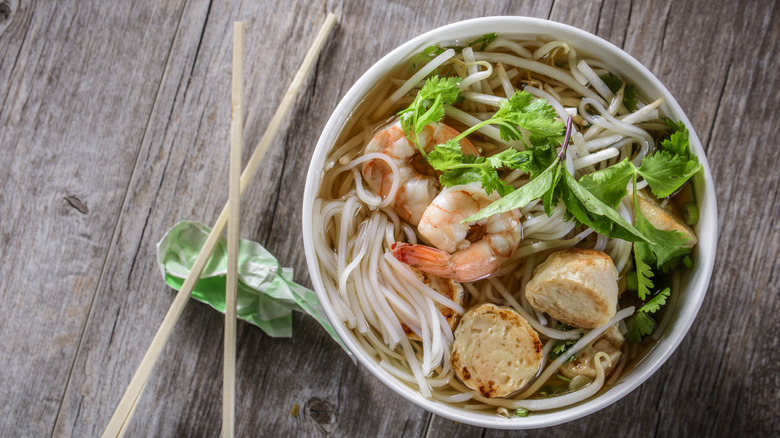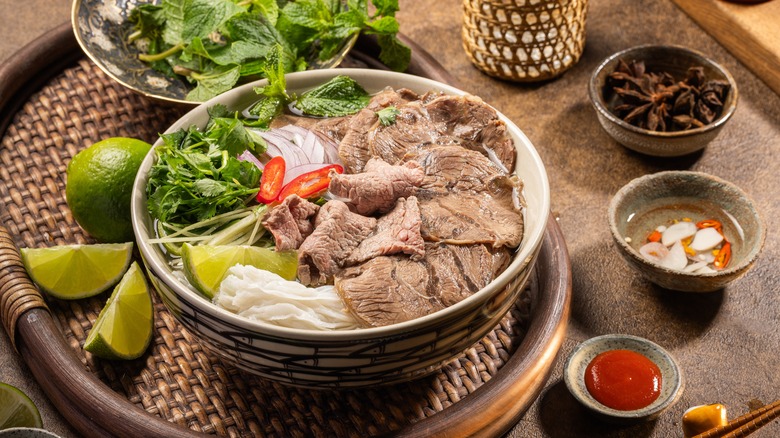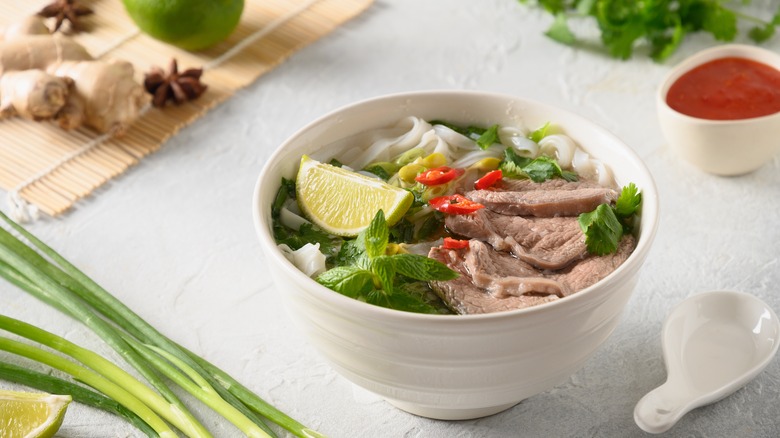Why Phở Is Considered A Traditional Vietnamese Breakfast Dish
If you've ever had a soup craving on a cold day, you've likely turned to pho. One of the national dishes of Vietnam, the rich, complex, savory noodle soup starts with seafood and beef flavors and extends outwards from there. It's a riotous, joyful mix of tastes involving herbs and spices like mint, ginger, cloves, and cilantro, with each bowlful including ingredients such as rice noodles, tofu, thin slices of beef, shrimp, bean sprouts, lime, and chiles.
In Vietnam, though, pho isn't traditionally eaten the way it is in other countries: In its origin country, pho is traditionally a breakfast dish. The idea of eating a flavorful fish-and/or-meat soup first thing in the morning may seem strange to people who aren't from Vietnam, but it makes sense if you think about it. Brothy pho sits right in that sweet spot where it's filling enough to be a complete meal, but it's also relatively light, meaning it's not going to make you feel lethargic as you go about your day.
Pho is best as a breakfast meal in a hot country like Vietnam
We don't know exactly what led to pho's creation in the first place. We know where and when it originated: In the late 19th and early 20th centuries in northern Vietnam. As far as what led to its evolution, though, we're basically going off guess-work. It's possible it evolved from the French meat and vegetable stew known as pot-au-feu (France colonized Vietnam until the mid-1900s), but it may instead derive from a Chinese beef noodle dish, the name of which contains a character with the phonetic pronunciation "fuh."
Commonly eaten before 9 a.m., pho has long been a favorite choice for breakfast in Vietnam, particularly for workers with physically demanding jobs. In addition to its inherent lightness, it's also a hot soup — and Vietnam is a tropical country. This means that the coolest parts of the day are generally in the morning, so that's the time when you're more likely to want to be warmed up.
Conversely, all of the things that make pho a great choice for breakfast have made it a much harder sell at dinnertime. You're not as concerned with lightness at dinner since you're going to be going to sleep soon anyway, and pho is not nearly as substantial as other soup options. It's also going to be a lot hotter at night, making hot soup less appealing.
Despite tradition, pho is now sold at all times of the day
Even in Vietnam, the customs around pho are changing a bit. Though it's still commonly eaten in the mornings, you can now get pho pretty much whenever you want, especially in major cities like Hanoi or Ho Chi Minh City. This is partially just humanity in general discovering that breakfast food is fun to eat at any time; the rise of breakfast for dinner certainly isn't purely a Vietnamese phenomenon.
But in addition to Vietnam's vastly growing economy, one thing that may have helped change the perspective on pho is its versatility. Though it's traditionally been light enough to be primarily a breakfast meal, it doesn't have to be. In southern Vietnam, generally larger portion sizes make pho, among other dishes, far more filling. The other thing about pho is you can add basically whatever you want to it as long as it fits with the flavor profile you're going for, turning a lighter meal into a heavier one with ease.
While pho's specific usage in Vietnamese culture might be seeing an evolution, it certainly isn't losing its cultural place. Change like this — at least in the form of increased availability and, in turn, heightened awareness of culinary traditions — can be considered a good thing.


